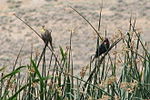Cold Springs, Washoe County, Nevada
Census-designated places in NevadaCensus-designated places in Washoe County, NevadaReno, NV Metropolitan Statistical AreaUse mdy dates from July 2023

Cold Springs is a census-designated place (CDP) in Washoe County, Nevada, United States. It is known as Eitse'ihpaa or Eitse'ippaa (literally "cold water" or "cold spring") in Shoshoni. It is located just off U.S. Route 395 in the northwestern part of the Reno–Sparks Metropolitan Statistical Area, adjacent to the California state line. The population was 8,544 at the 2010 census.
Excerpt from the Wikipedia article Cold Springs, Washoe County, Nevada (License: CC BY-SA 3.0, Authors, Images).Cold Springs, Washoe County, Nevada
Cold Springs Drive,
Geographical coordinates (GPS) Address Nearby Places Show on map
Geographical coordinates (GPS)
| Latitude | Longitude |
|---|---|
| N 39.676944444444 ° | E -119.96777777778 ° |
Address
Cold Springs Drive 17463
89508
Nevada, United States
Open on Google Maps





